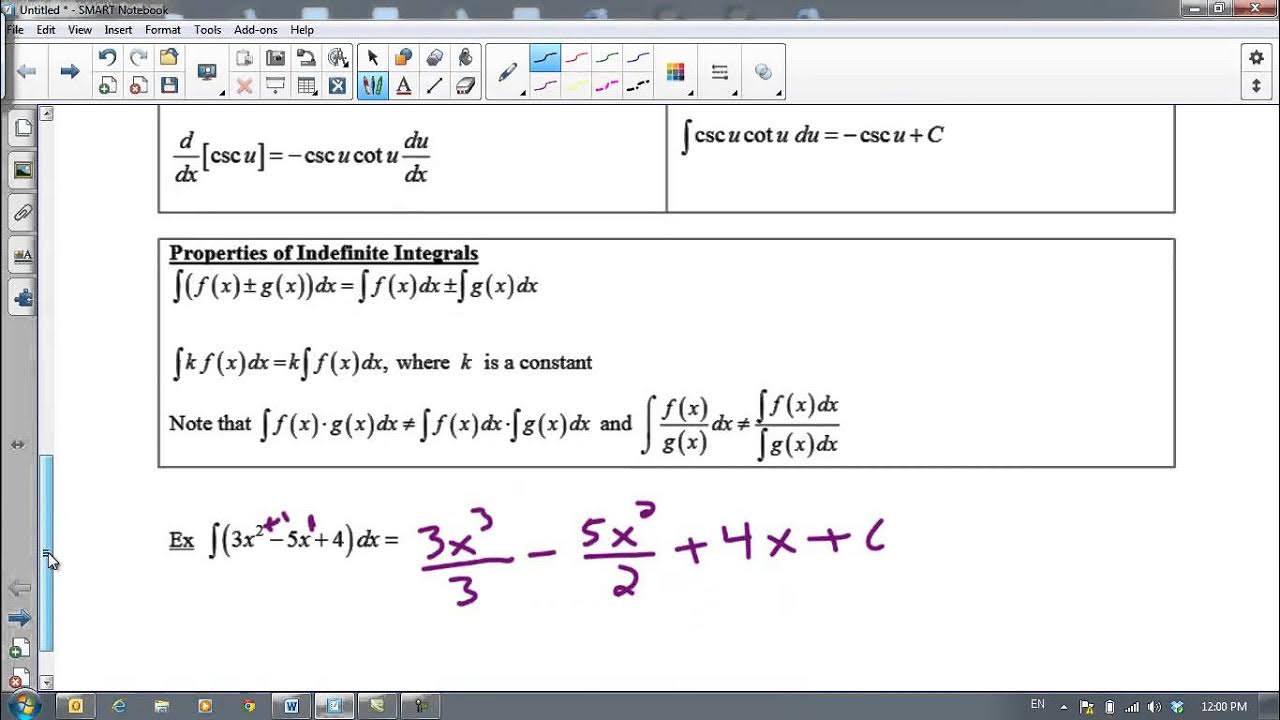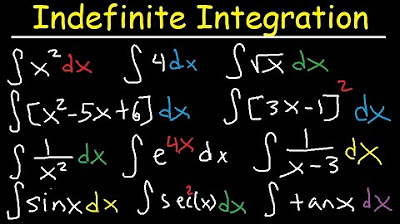Integrating Exponential Functions
TLDRThis educational video script covers the integration of exponential functions involving 'e'. It begins with the fundamental derivatives of exponential functions and progresses to substitution techniques, demonstrating how to integrate various forms of 'e' to the power of a variable. The script provides several examples, including indefinite integrals and definite integrals over specific intervals, illustrating the process step by step. It also touches on solving differential equations and calculating the volume of water pumped into a tank, offering a comprehensive guide to integrating exponential functions.
Takeaways
- 📈 The derivative of e^x is e^x.
- 🧮 For e^u, the derivative is e^u * u'.
- 🔄 The integral of e^u * du is e^u + C.
- 🧑🏫 Example 1: Let u = 3x + 1. The integral of e^{3x+1} is (1/3) e^{3x+1} + C.
- 📚 Example 2: Let u = -x^2. The integral of e^{-x^2} is -(5/2) e^{-x^2} + C.
- 🧩 Example 3: Let u = x^{-1}. The integral of e^{x^{-1}} is -e^{x^{-1}} + C.
- 📐 Example 4: Let u = cos x. The integral of e^{cos x} is -e^{cos x} + C.
- 📊 Example 5: For a definite integral from 0 to 1, substitute the limits after finding the integral.
- 🔍 Example 6: Use substitution u = cos(e^x) for complex integrals.
- 🧮 For solving differential equations, integrate both sides and use initial conditions to find constants.
Q & A
What is the derivative of e to the power of x with respect to x?
-The derivative of e to the power of x (e^x) with respect to x is e^x itself.
If the derivative of a function is e to the power of u times u prime, what is the integral of e to the power of u with respect to u?
-The integral of e to the power of u (e^u) with respect to u is e^u plus a constant C.
In the context of the script, what is the substitution method used for integrating exponential functions?
-The substitution method involves letting u be an expression involving x, finding du/dx, and then solving for dx in terms of du, which allows for the integral of e^u to be simplified and solved.
What is the integral of e to the power of (3x + 1) with respect to x?
-The integral of e^(3x + 1) with respect to x is (1/3)e^(3x + 1) plus a constant C.
How is the integral of e to the power of (-x^2) simplified in the script?
-The integral of e^(-x^2) is simplified by taking out the constant coefficient 5, resulting in -5/2 times the integral of e^(-x^2) times dx, which then becomes -5/2 * e^(-x^2) plus a constant C.
What is the integral of e to the power of (1/x) with respect to x?
-The integral of e^(1/x) with respect to x is -e^(1/x) plus a constant C, after substituting u = 1/x and solving for dx in terms of du.
How is the integral of e to the power of cos(x) with respect to x approached in the script?
-The integral of e^(cos(x)) with respect to x is approached by substituting u = cos(x), which gives du/dx = -sin(x), and then solving for dx in terms of du, resulting in the integral of -e^u * du, which simplifies to -e^(cos(x)) plus a constant C.
What is the process for solving a definite integral with a natural logarithm in the denominator, as shown in the script?
-The process involves substituting the bottom of the fraction with u, finding du/dx, and then solving for dx in terms of du. The integral is then evaluated from the upper to the lower limit of integration, and the fundamental theorem of calculus is applied to find the difference between the evaluated limits.
How does the script handle the integration of the product of cosine and an exponential function?
-The script suggests substituting u with the argument of the cosine function, finding du/dx, and then solving for dx in terms of du. The integral of the product becomes the integral of cosine(u) times du, which simplifies to the sine of u evaluated from the limits of integration.
What is the approach to solving a differential equation of the form dy = e^x - e^(-x) dx?
-The approach involves separating variables and integrating both sides. The integral of dy is y, and the integral of the right-hand side involves recognizing the product of e^x and e^(-x) as e^(2x)/2, which is then integrated term by term.
How is the particular solution to a differential equation found in the script?
-The particular solution is found by integrating the function to find the first derivative, then integrating again to find the original function, and finally applying the initial condition to determine the constant of integration.
What is the method for calculating the total amount of water pumped into a tank over a certain time period, as described in the script?
-The method involves integrating the rate function R(t) from time 0 to the desired time period (in this case, 5 minutes). The result of this integration gives the total change in the amount of water in the tank.
Outlines
📘 Introduction to Integrating Exponential Functions
The speaker introduces the topic of integrating exponential functions involving the constant e. They recap the derivatives of e^x and e^u, emphasizing the formula for integration. They proceed with an example where u is set to 3x + 1, showing the step-by-step process to solve for the integral, ultimately arriving at the solution 1/3 e^(3x + 1) + C.
📝 Further Examples of Integration
The speaker continues with more examples of integrating exponential functions. In the first example, they set u to -x^2 and demonstrate the integration process, leading to -5/2 e^(-x^2) + C. Another example involves setting u to x^-1, and they detail the steps to integrate e^(x^-1) using substitution, resulting in -e^(x^-1) + C.
🔍 Complex Integrals and Definite Integrals
The speaker tackles more complex integrals, showing how to handle integrals involving fractions and trigonometric functions. They explain the process of letting u equal the exponent on e and provide detailed steps for substitution and integration. An example with definite integrals is given, demonstrating how to handle limits of integration and evaluate the result.
Mindmap
Keywords
💡Integration
💡Exponential Functions
💡Derivative
💡U-Substitution
💡Antiderivatives
💡Natural Logarithm
💡Definite Integrals
💡Differential Equations
💡Initial Condition
💡Rate of Change
Highlights
Introduction to integrating exponential functions with base 'e', emphasizing the derivative of e^x as e^x.
Explanation of the derivative of e^u as e^u * u', where u is a function of x.
Integration formula for e^u du, resulting in e^u + C.
Practice example with u = 3x + 1, illustrating the substitution method.
Solving for dx in terms of du/dx, simplifying the integral.
Second example with u = -x^2, showcasing the process of integrating with a quadratic function.
Integration of e^(-x^2) with a focus on the du/dx transformation.
Third example with u = x^(-1), demonstrating the integration of a function with a reciprocal exponent.
Integration of e^(cos(x)) with a focus on trigonometric substitution.
Solving a definite integral with a natural log transformation.
Evaluating the definite integral from 2 to 1 + e using properties of logarithms.
Integration of cos(u) with a focus on the argument substitution inside a cosine function.
Solving a differential equation by separating variables and integrating both sides.
Finding a particular solution to a differential equation with an initial condition.
Calculating the amount of water pumped into a tank using integration of a rate function.
Final example demonstrates the practical application of integration in calculating the volume of water in a tank over time.
Transcripts
Browse More Related Video

Integrating Exponential Functions By Substitution - Antiderivatives - Calculus

Business Calculus - Math 1329 - Section 5.1 - Indefinite Integration & Differential Equations

Antiderivatives and Indefinite Integrals

Indefinite Integral - Basic Integration Rules, Problems, Formulas, Trig Functions, Calculus

Calculus Chapter 3 Lecture 17 Indefinite Integrals

Indefinite Integral of Exponential Functions | Calculus
5.0 / 5 (0 votes)
Thanks for rating: